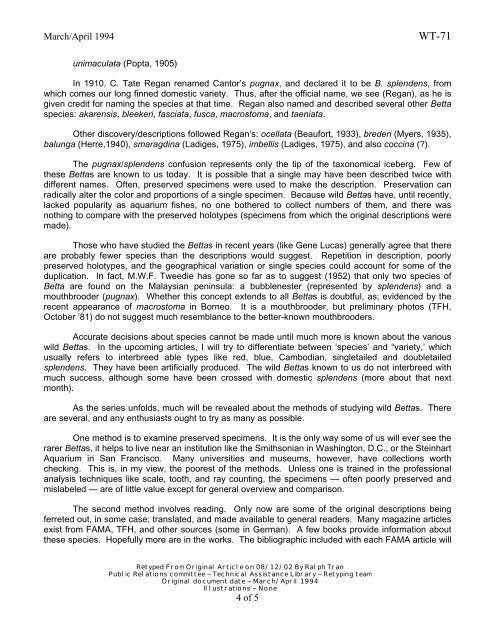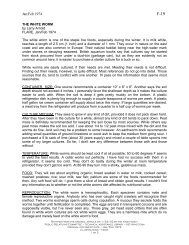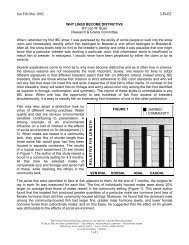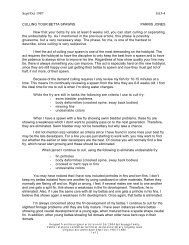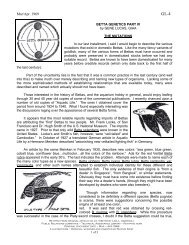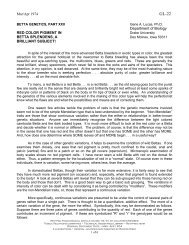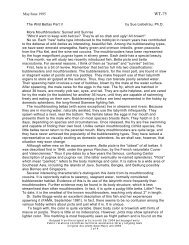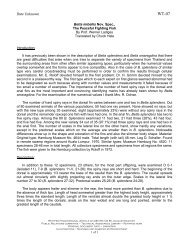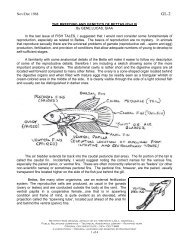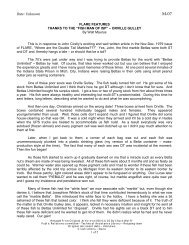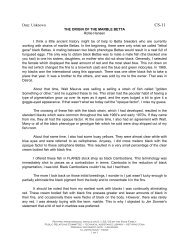WT-71: The Wild Bettas â Part 1 - International Betta Congress
WT-71: The Wild Bettas â Part 1 - International Betta Congress
WT-71: The Wild Bettas â Part 1 - International Betta Congress
You also want an ePaper? Increase the reach of your titles
YUMPU automatically turns print PDFs into web optimized ePapers that Google loves.
March/April 1994<br />
<strong>WT</strong>-<strong>71</strong><br />
unimaculata (Popta, 1905)<br />
In 1910, C. Tate Regan renamed Cantor’s pugnax, and declared it to be B. splendens, from<br />
which comes our long finned domestic variety. Thus, after the official name, we see (Regan), as he is<br />
given credit for naming the species at that time. Regan also named and described several other <strong>Betta</strong><br />
species: akarensis, bleekeri, fasciata, fusca, macrostoma, and taeniata.<br />
Other discovery/descriptions followed Regan’s: ocellata (Beaufort, 1933), brederi (Myers, 1935),<br />
balunga (Herre,1940), smaragdina (Ladiges, 1975), imbellis (Ladiges, 1975), and also coccina (?).<br />
<strong>The</strong> pugnax/splendens confusion represents only the tip of the taxonomical iceberg. Few of<br />
these <strong><strong>Betta</strong>s</strong> are known to us today. It is possible that a single may have been described twice with<br />
different names. Often, preserved specimens were used to make the description. Preservation can<br />
radically alter the color and proportions of a single specimen. Because wild <strong><strong>Betta</strong>s</strong> have, until recently,<br />
lacked popularity as aquarium fishes, no one bothered to collect numbers of them, and there was<br />
nothing to compare with the preserved holotypes (specimens from which the original descriptions were<br />
made).<br />
Those who have studied the <strong><strong>Betta</strong>s</strong> in recent years (like Gene Lucas) generally agree that there<br />
are probably fewer species than the descriptions would suggest. Repetition in description, poorly<br />
preserved holotypes, and the geographical variation or single species could account for some of the<br />
duplication. In fact, M.W.F. Tweedie has gone so far as to suggest (1952) that only two species of<br />
<strong>Betta</strong> are found on the Malaysian peninsula: a bubblenester (represented by splendens) and a<br />
mouthbrooder (pugnax). Whether this concept extends to all <strong><strong>Betta</strong>s</strong> is doubtful, as; evidenced by the<br />
recent appearance of macrostoma in Borneo. It is a mouthbrooder, but preliminary photos (TFH,<br />
October ’81) do not suggest much resemblance to the better-known mouthbrooders.<br />
Accurate decisions about species cannot be made until much more is known about the various<br />
wild <strong><strong>Betta</strong>s</strong>. In the upcoming articles, I will try to differentiate between ‘species’ and “variety,’ which<br />
usually refers to interbreed able types like red, blue, Cambodian, singletailed and doubletailed<br />
splendens. <strong>The</strong>y have been artificially produced. <strong>The</strong> wild <strong><strong>Betta</strong>s</strong> known to us do not interbreed with<br />
much success, although some have been crossed with domestic splendens (more about that next<br />
month).<br />
As the series unfolds, much will be revealed about the methods of studying wild <strong><strong>Betta</strong>s</strong>. <strong>The</strong>re<br />
are several, and any enthusiasts ought to try as many as possible.<br />
One method is to examine preserved specimens. It is the only way some of us will ever see the<br />
rarer <strong><strong>Betta</strong>s</strong>, it helps to live near an institution like the Smithsonian in Washington, D.C., or the Steinhart<br />
Aquarium in San Francisco. Many universities and museums, however, have collections worth<br />
checking. This is, in my view, the poorest of the methods. Unless one is trained in the professional<br />
analysis techniques like scale, tooth, and ray counting, the specimens — often poorly preserved and<br />
mislabeled — are of little value except for general overview and comparison.<br />
<strong>The</strong> second method involves reading. Only now are some of the original descriptions being<br />
ferreted out, in some case; translated, and made available to general readers. Many magazine articles<br />
exist from FAMA, TFH, and other sources (some in German). A few books provide information about<br />
these species. Hopefully more are in the works. <strong>The</strong> bibliographic included with each FAMA article will<br />
Retyped From Original Article on 08/12/02 By Ralph Tran<br />
Public Relations committee ~ Technical Assistance Library ~ Retyping team<br />
Original document date ~ March/April 1994<br />
Illustrations ~ None<br />
4 of 5


